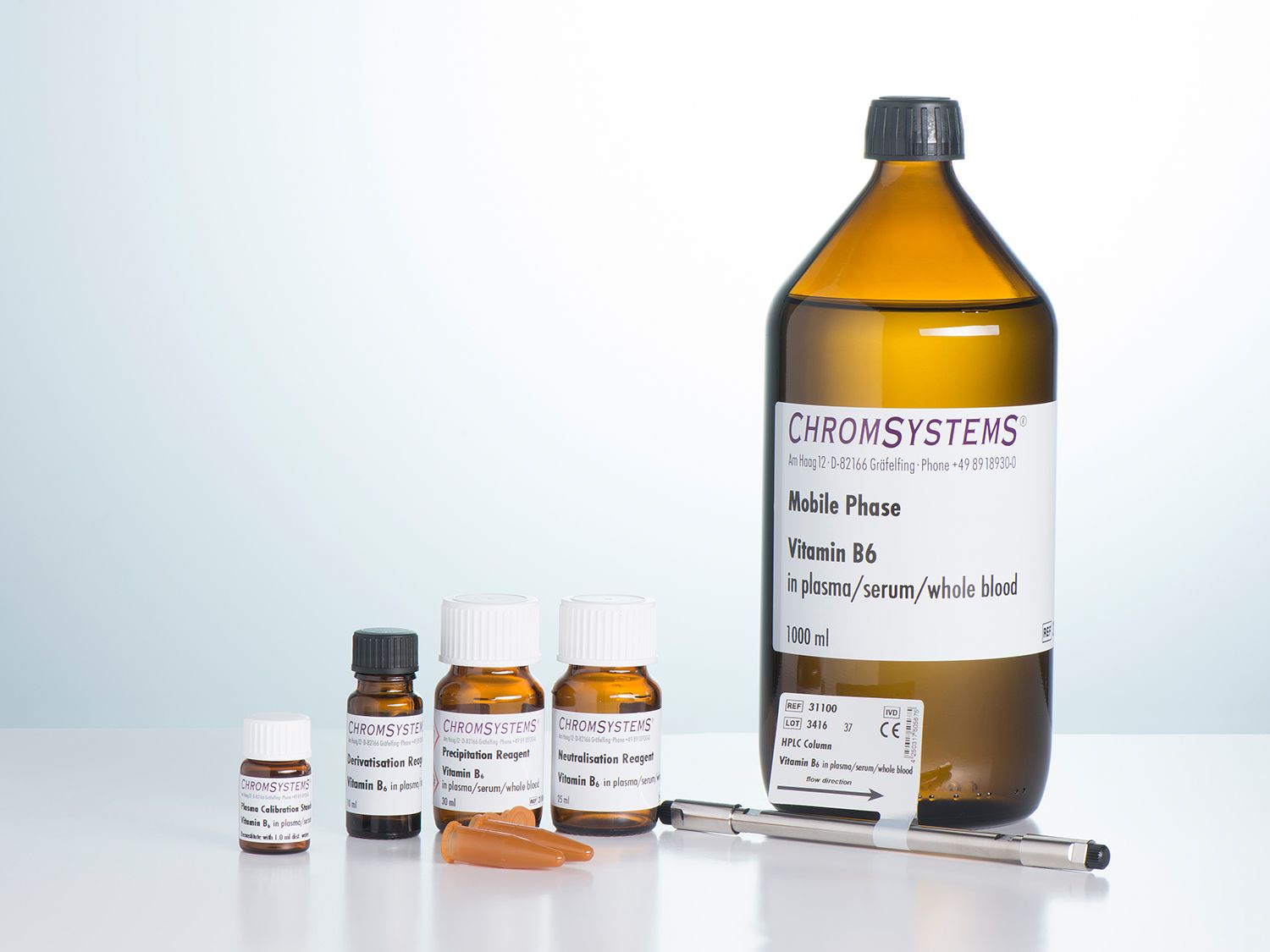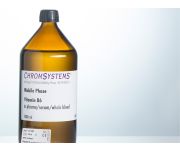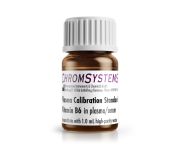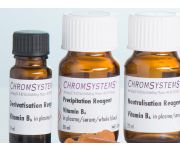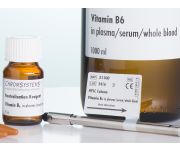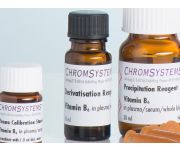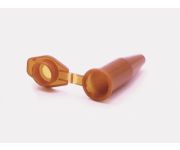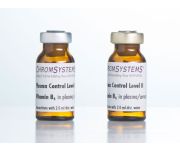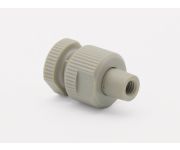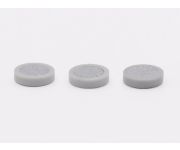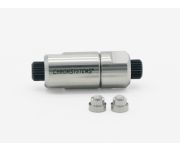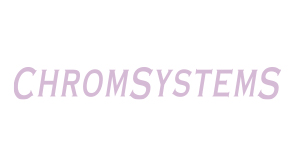Vitamin B6 in Serum/Plasma – HPLC Reagent Kit
Assay validated according to IVDR (=> Declaration of Conformity)
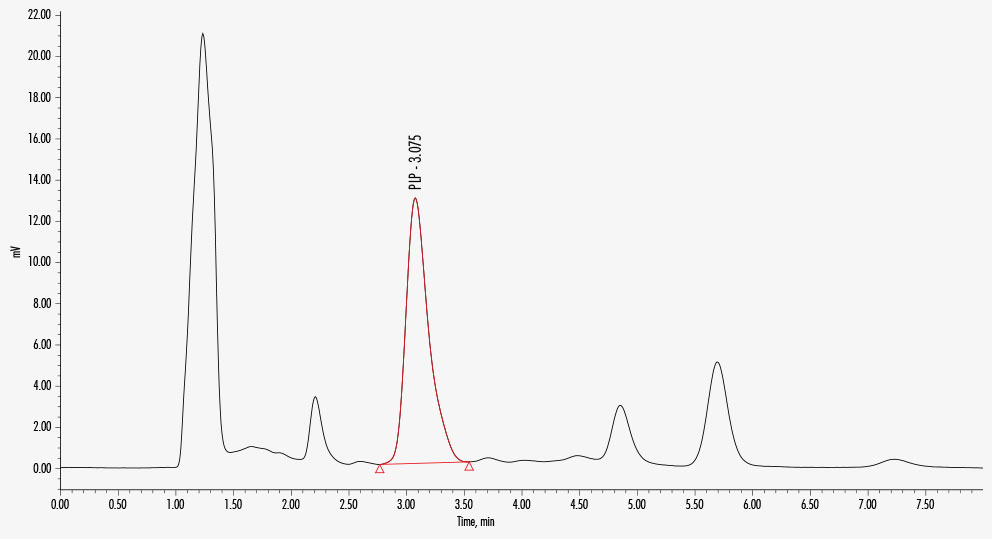

Vitamin B6 (PLP, pyridoxal 5’-phosphate)
Clinical relevance
This assay allows the quantitative determination of the physiologically active form of vitamin B6, pyridoxal 5‘-phosphate, in human serum or plasma samples by HPLC.
It is intended to be used for determination of vitamin B6 levels where indicated
• in patients with suspected vitamin B6 deficiency,
• in patients with suspected vitamin B6 excess,
• in patients under vitamin B6 supplementation therapy.
Assay characteristics
Instead of the usual, technically demanding post-column derivatisation, simple precolumn derivatisation is used. The sample clean-up procedure includes an effective protein precipitation and extraction step to liberate PLP from its bound status. Subsequent derivatisation produces a fluorescent PLP-derivative. The chromatographic determination is run on an isocratic HPLC system with fluorescence detection.
Detailed performance evaluation data can be found in Appendices II and III of the instruction manual.
Two types of kits available
Basic Kit
• Only sample preparation reagents and vials included
• No excess quantities of mobile phase and calibrators
|
31000-BK Basic Kit |
|
| 31004 | Precipitation Reagent, 30 ml (1x) |
| 31005 | Neutralisation Buffer, 25 ml (1x) |
| 31006 | Derivatisation Reagent, 10 ml (1x) |
| 33005 | Reaction Vials, 1.5 ml, amber colour (light protection), 100 pcs. (2x) |
Reagent Kit
• Mobile phase and calibrator included
|
31000/S Reagent Kit |
|
| 31004 | Precipitation Reagent, 30 ml (1x) |
| 31005 | Neutralisation Buffer, 25 ml (1x) |
| 31006 | Derivatisation Reagent, 10 ml (1x) |
| 33005 | Reaction Vials, 1.5 ml, amber colour (light protection), 100 pcs. (2x) |
| 31001 | Mobile Phase, 1000 ml, (1x) |
| 36005 | Plasma Calibration Standard, 5 x 1 ml (lyoph.), (1x) |
| Method of Analysis | HPLC |
|---|---|
| Number of Tests | 100 |
| Please note | The information listed here, including the sample preparation, is not sufficient for using the product. Please read the information provided in the instruction manual, which includes detailed information on limitations associated with the use of the product in line with its intended purpose. Detailed performance evaluation data can be found in Appendices II and III of the instruction manual. |
| Lower and Upper Limit of Quantitation | Plasma: 0.7 – 250 µg/l |
| Specimen | Plasma / Serum |
| Sample Preparation | The information on the sample preparation presented here is not sufficient for use in the laboratory. For a detailed step by step description, please refer to the instruction manual. • Pipette 200 µl sample/calibrator/control into an amber coloured reaction vial. |
| Run Time | 8 min |
| Injection Volume | 50 µl |
| Flow Rate | 1.0 ml/min |
| Column Temperature | +20 to +25 °C |
| Wavelengths | EX 320 nm |
| Additional Info | Every isocratic HPLC system with fluorescence detector is suitable. |
| Parameters | Vitamin B6 (PLP, pyridoxal 5’-phosphate) |
Vitamin B6 in Serum/Plasma – HPLC Reagent Kit (31000/S)
For 100 tests
| Order No. | Reagent Kit components (Quantities in kit) |
| 31001 | Mobile Phase, 1000 ml, (1x) |
| 36005 | Plasma Calibration Standard, 5 x 1 ml (lyoph.), (1x) |
| 31004 | Precipitation Reagent, 30 ml (1x) |
| 31005 | Neutralisation Buffer, 25 ml (1x) |
| 31006 | Derivatisation Reagent, 10 ml (1x) |
| 33005 | Reaction Vials, 1.5 ml, amber colour (light protection), 100 pcs. (2x) |
| Order No. | Required components (not included in the Reagent Kit) |
| 31110 | HPLC Column, equilibrated, with test chromatogram, 1 pc. |
| 0038 | Vitamin B6 Plasma Control, Level I (lyoph.), 5 x 2 ml |
| 0039 | Vitamin B6 Plasma Control, Level II (lyoph.), 5 x 2 ml |
| Order No. | Lab equipment |
| 33005 | Reaction Vials, 1.5 ml, amber colour (light protection), 100 pcs. |
| 15010 | PEEK Prefilter Housing, 1 pc. |
| 15011 | PEEK-encased Prefilter, 2 µm, 5 pcs. |
| 18001 | Precolumn Cartridge Holder 4/10, 1 pc. |
| 18010 | Precolumn Cartridge 4/10, 1 pc. |
-
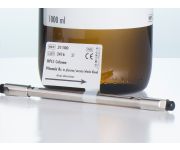 HPLC Column Vitamin B6 in Whole Blood/Serum/PlasmaOrder no.: 31100
HPLC Column Vitamin B6 in Whole Blood/Serum/PlasmaOrder no.: 31100Vitamin B6 in Whole Blood/Serum/Plasma - HPLC
-
 HPLC Column Vitamin B6 in Whole Blood/Serum/PlasmaOrder no.: 31100
HPLC Column Vitamin B6 in Whole Blood/Serum/PlasmaOrder no.: 31100Vitamin B6 in Whole Blood/Serum/Plasma - HPLC


Vitamin B6 (PLP, pyridoxal 5’-phosphate)
Clinical relevance
This assay allows the quantitative determination of the physiologically active form of vitamin B6, pyridoxal 5‘-phosphate, in human serum or plasma samples by HPLC.
It is intended to be used for determination of vitamin B6 levels where indicated
• in patients with suspected vitamin B6 deficiency,
• in patients with suspected vitamin B6 excess,
• in patients under vitamin B6 supplementation therapy.
Assay characteristics
Instead of the usual, technically demanding post-column derivatisation, simple precolumn derivatisation is used. The sample clean-up procedure includes an effective protein precipitation and extraction step to liberate PLP from its bound status. Subsequent derivatisation produces a fluorescent PLP-derivative. The chromatographic determination is run on an isocratic HPLC system with fluorescence detection.
Detailed performance evaluation data can be found in Appendices II and III of the instruction manual.
Two types of kits available
Basic Kit
• Only sample preparation reagents and vials included
• No excess quantities of mobile phase and calibrators
|
31000-BK Basic Kit |
|
| 31004 | Precipitation Reagent, 30 ml (1x) |
| 31005 | Neutralisation Buffer, 25 ml (1x) |
| 31006 | Derivatisation Reagent, 10 ml (1x) |
| 33005 | Reaction Vials, 1.5 ml, amber colour (light protection), 100 pcs. (2x) |
Reagent Kit
• Mobile phase and calibrator included
|
31000/S Reagent Kit |
|
| 31004 | Precipitation Reagent, 30 ml (1x) |
| 31005 | Neutralisation Buffer, 25 ml (1x) |
| 31006 | Derivatisation Reagent, 10 ml (1x) |
| 33005 | Reaction Vials, 1.5 ml, amber colour (light protection), 100 pcs. (2x) |
| 31001 | Mobile Phase, 1000 ml, (1x) |
| 36005 | Plasma Calibration Standard, 5 x 1 ml (lyoph.), (1x) |
| Method of Analysis | HPLC |
|---|---|
| Number of Tests | 100 |
| Please note | The information listed here, including the sample preparation, is not sufficient for using the product. Please read the information provided in the instruction manual, which includes detailed information on limitations associated with the use of the product in line with its intended purpose. Detailed performance evaluation data can be found in Appendices II and III of the instruction manual. |
| Lower and Upper Limit of Quantitation | Plasma: 0.7 – 250 µg/l |
| Specimen | Plasma / Serum |
| Sample Preparation | The information on the sample preparation presented here is not sufficient for use in the laboratory. For a detailed step by step description, please refer to the instruction manual. • Pipette 200 µl sample/calibrator/control into an amber coloured reaction vial. |
| Run Time | 8 min |
| Injection Volume | 50 µl |
| Flow Rate | 1.0 ml/min |
| Column Temperature | +20 to +25 °C |
| Wavelengths | EX 320 nm |
| Additional Info | Every isocratic HPLC system with fluorescence detector is suitable. |
| Parameters | Vitamin B6 (PLP, pyridoxal 5’-phosphate) |
Vitamin B6 in Serum/Plasma – HPLC Reagent Kit (31000/S)
For 100 tests
| Order No. | Reagent Kit components (Quantities in kit) |
| 31001 | Mobile Phase, 1000 ml, (1x) |
| 36005 | Plasma Calibration Standard, 5 x 1 ml (lyoph.), (1x) |
| 31004 | Precipitation Reagent, 30 ml (1x) |
| 31005 | Neutralisation Buffer, 25 ml (1x) |
| 31006 | Derivatisation Reagent, 10 ml (1x) |
| 33005 | Reaction Vials, 1.5 ml, amber colour (light protection), 100 pcs. (2x) |
| Order No. | Required components (not included in the Reagent Kit) |
| 31110 | HPLC Column, equilibrated, with test chromatogram, 1 pc. |
| 0038 | Vitamin B6 Plasma Control, Level I (lyoph.), 5 x 2 ml |
| 0039 | Vitamin B6 Plasma Control, Level II (lyoph.), 5 x 2 ml |
| Order No. | Lab equipment |
| 33005 | Reaction Vials, 1.5 ml, amber colour (light protection), 100 pcs. |
| 15010 | PEEK Prefilter Housing, 1 pc. |
| 15011 | PEEK-encased Prefilter, 2 µm, 5 pcs. |
| 18001 | Precolumn Cartridge Holder 4/10, 1 pc. |
| 18010 | Precolumn Cartridge 4/10, 1 pc. |
-
 HPLC Column Vitamin B6 in Whole Blood/Serum/PlasmaOrder no.: 31100
HPLC Column Vitamin B6 in Whole Blood/Serum/PlasmaOrder no.: 31100Vitamin B6 in Whole Blood/Serum/Plasma - HPLC
-
 HPLC Column Vitamin B6 in Whole Blood/Serum/PlasmaOrder no.: 31100
HPLC Column Vitamin B6 in Whole Blood/Serum/PlasmaOrder no.: 31100Vitamin B6 in Whole Blood/Serum/Plasma - HPLC

